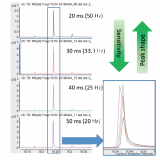Coupling GCxGC with QTOF detection in MS/MS mode: a feasibility study
18-07-2019
Coupling GCxGC with QTOF detection in MS/MS mode: a feasibility study
Our application specialist Daniela Peroni has published a new application note about Coupling GCxGC with QTOF detection in MS/MS mode.
The Agilent 7250 QTOF detector delivers high-resolution MS data, tunable ionization energy and MS/MS capability. Accurate-mass spectra with classic ionization can therefore be complemented with soft ionization spectra as well as MS/MS data for identity confirmation of targets and structure elucidation of unknowns. This makes GC-QTOF valuable for challenging applications that demand confident identification in highly complex matrices (e.g. metabolomics, pesticides analysis).
Comprehensive two-dimensional gas chromatography (GC×GC) is the chromatographic method of choice to unravel high sample complexity. Compared to classic GC, GC×GC grants superior separation power and unmatched peak capacity by coupling two different separation mechanism in a single analysis. Co-elutions are avoided or minimized, granting easier identification and more reliable quantification.
Several examples are available for GC×GC in combination with the QTOF used in scan mode as a HRMS-TOF detector. The elevated number of resolved peaks and the clean 2D spectra, in combination with formula generation based on accurate-mass data, allow more precise and informative profiling. However, up to now GC×GC is hardly used in combination with the QTOF in MS/MS mode. In the full application note the feasibility of GC×GC-QTOF-MS/MS is investigated.
Read the full application note here
« News overview
